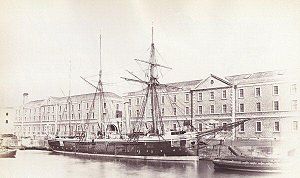HMS Wasp (1880)
 HMS Wasp | |
| Career (United Kingdom) | |
|---|---|
| Name: | HMS Wasp |
| Builder: | Barrow Iron Shipbuilding |
| Yard number: | 71 |
| Launched: | 5 October 1880 |
| Commissioned: | 1 December 1881 |
| Fate: |
Wrecked on 22 September 1884 Wreck sold in November 1910 |
| General characteristics | |
| Class and type: | Banterer-class composite screw gunboat |
| Displacement: | 465 tons |
| Length: | 125 ft (38.1 m) pp |
| Beam: | 23 ft 6 in (7.2 m) |
| Draught: | 10 ft (3.05 m) |
| Installed power: | 440 indicated horsepower (330 kW) |
| Propulsion: |
|
| Speed: | 9.5 knots (18 km/h) |
| Range: | 40 tons coal |
| Complement: | 60 |
| Armament: |
|
HMS Wasp was a Banterer-class composite screw gunboat of the Royal Navy, built in 1880 by Barrow Iron Shipbuilding and wrecked off Tory Island in 1884.
Contents
Construction
Designed by Nathaniel Barnaby, the Royal Navy Director of Naval Construction, her hull was of composite construction; that is, iron keel, frames, stem and stern posts with wooden planking.[1] She was fitted with a 2-cylinder horizontal compound-expansion steam engine driving a single screw. She was rigged with three masts, with square rig on the foremast only, making her a barquentine-rigged vessel. Her keel was laid at Barrow Iron Shipbuilding as yard number 71 and she was launched on 5 October 1880.[1]
Career
Wasp was commissioned on 1 December 1881.[1]
Fate
On her final voyage Wasp, under the command of Lieutenant J D Nicholls,[2] was sailing from Westport, County Mayo to Moville, County Donegal to pick up a party of police, bailiffs and court officials. These were to be transported to Inishtrahull Island off Malin Head to carry out evictions for non-payment of rents. The same ship had delivered urgently-needed supplies of seed potatoes to the same islanders the previous year. The ship struck rocks off Tory Island on 22 September 1884, and sank with a loss of 52 lives.[3] The wreck was sold to the Cornish Salvage Co. in November 1910.[4]
Notes
- ↑ 1.0 1.1 1.2 Winfield, p.298
- ↑ "HMS Wasp at the Naval Database website". http://www.pbenyon.plus.com/18-1900/W/05148.html. Retrieved 2010-02-10.
- ↑ "Tory Island Visitors' Centre website". http://toryislandvisitorscentre.org/history/7/tory.html. Retrieved 2010-02-10.
- ↑ "HMS Wasp at Irish Wrecks Online website". http://www.irishwrecksonline.net/details/WaspHMS991.htm. Retrieved 2010-02-10.
References
- Colledge, J. J.; Warlow, Ben (2006) [1969]. Ships of the Royal Navy: the complete record of all fighting ships of the Royal Navy (Rev. ed.). London: Chatham. ISBN 9781861762818. OCLC 67375475.
- Winfield, Rif; Lyon, David (2003). The Sail and Steam Navy List, 1815-1889. Chatham Publishing. ISBN 978-1861760326.
| ||||||||
